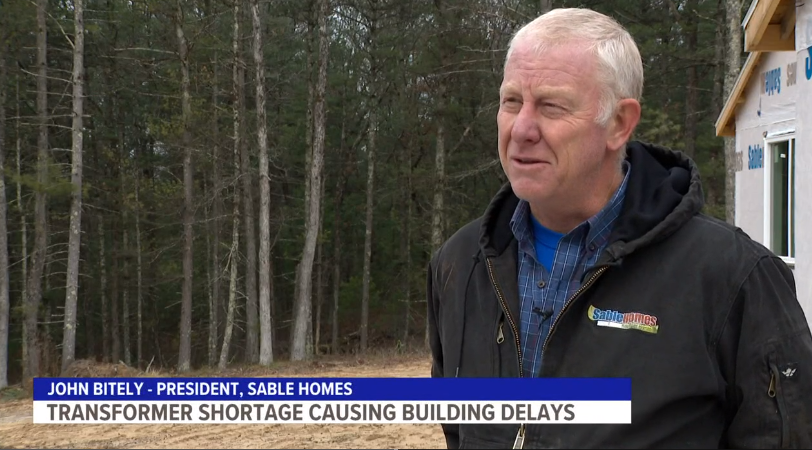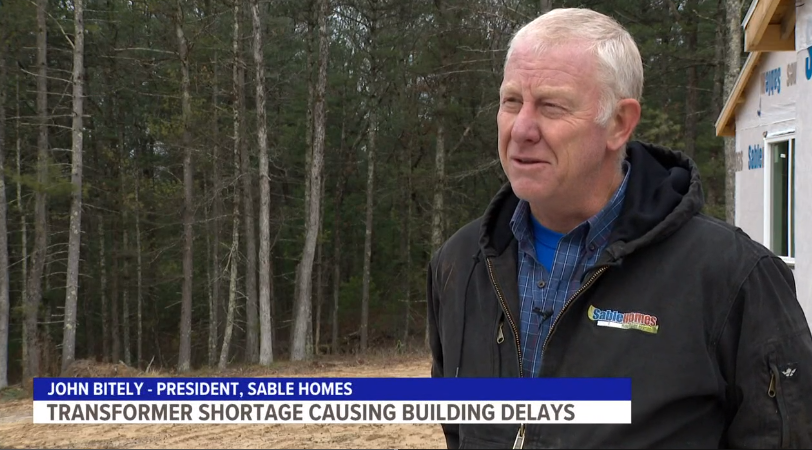
John Bitely: Transformer shortage causing major delays in home construction nationwide
A high global demand for specialized steel and wiring has caused a critical shortage of electrical transformers, leaving some nearly-finished new home construction projects unlivable.
In an interview with WZZM 13, John Bitely, president of Sable Homes, said the transformer shortage isn’t just a local or statewide issue, but it’s happening nationwide. “It is a real problem.”
According to the Edison Electric Institute, a survey done by the American Public Power Association in the beginning of 2022 showed their members were having to wait an average of a year for a delivery of new transformers. In 2018, the wait was only about three months.
The National Association of Home Builders and five building and utility trade groups shared its concerns about the transformer shortage in a letter to the Biden Administration in November, asking them to take action and address the shortage transformers.
“We’re having problems getting electricity to hook up to the projects we’re building like homes, apartments and condominiums,” Bitely told WZZM 13.
A home under construction in Sable Homes’ River Hills community in Newaygo has been ready for its electric to be turned on since Sept. 23.
“The drywall is all hung in this house and it’s ready for mudding, but we can’t finish it,” Bitely told WZZM 13 as they walked through the home on Tuesday, Dec. 6. The house still needs about two months of work to be finished, and the owners are planning to move in in March.
Consumers Energy estimated it will be months before they can turn on the electricity.
“If we can’t finish the home on time, that pushes the homeowners past their mortgage and they will lose their interest rate lock,” said Bitely. “Plus, they may not have anywhere to live.”
Bitely explained that they can’t work on the house without electric, because they need to warm the home for dehumidification, and to make sure that supplies don’t freeze or get damaged.
“We’re at the point where we’re ready to do drywall, but we can’t without heating up the home because otherwise, it’ll freeze and get ruined,” Bitely said. “In the summer months, we can get by because it doesn’t freeze at night,” he added, “but we’re now past that timeframe.”
For now, Sable Homes plans to buy a generator to warm the house and finish construction.
“So, we’ll have that running 24/7 for two months to have the home done in time,” said Bitely. “And we will eat the cost of that which could get up to nearly $5,000.”
The shortage is causing a burden for the builders, but more importantly, the buyers who need a place to live, he said.
“We’re stuck in the middle, and we’d like our customers to be happy,” Bitely said in his interview. “We don’t want to have to tell them ‘oh look at this nice new home that you can’t move in to.'”
“And because [Consumers Energy] is a utility company, it seems is that we as consumers have no choice,” he added. “If you’ve only got one supplier, one source, it’s frustrating but we’re stuck and we have to deal with them.”
In a statement to WZZM 13, Consumers Energy said: “Consumers Energy has been actively communicating to those requesting new service installation that their work may be delayed due to national equipment shortages and Consumers Energy is taking every step possible to secure the equipment we need to serve our customers.”
In a joint letter sent to the leaders of the House and Senate appropriations committees, NAHB, American Public Power Association, Associated General Contractors of America, Edison Electric Institute, Leading Builders of America and the National Rural Electric Cooperative Association, urged Congress to allocate $1 billion to address the growing supply-chain crisis for electric distribution transformers.
The letter stated that “throughout 2022, the electric sector and representatives from residential and commercial building sectors have been calling attention to the unprecedented supply-chain challenges both industries have been facing in procuring equipment used to maintain and grow the electric grid.”
Electric utilities continue to have significant problems in procuring distribution transformers needed to provide reliable electric service, and restore power following severe storms and natural disasters.
The trade groups noted that in housing construction, this is further exacerbating the ability of home builders to address the housing affordability crisis facing our nation.
NAHB has taken the lead in sounding the alarm since late last year that construction and electrification projects are being deferred or cancelled due to the inability to procure distribution transformer across all segments of the electric industry.
The trade groups informed lawmakers that orders for transformers that previously took two to four months to fill are now taking on average over a year. To address labor and material shortages focused specifically on the production of distribution transformers, Congress is being urged to use its authority under the Defense Production Act to expedite production of depleted stockpiles.
Watch Bitely’s full interview, here.

